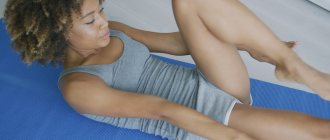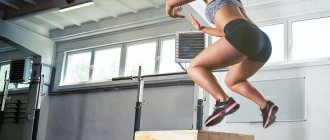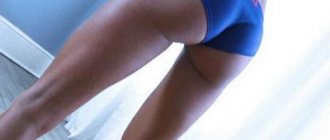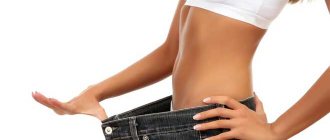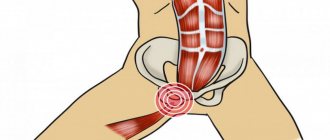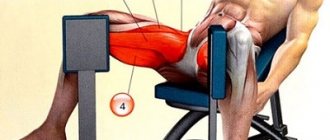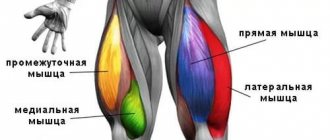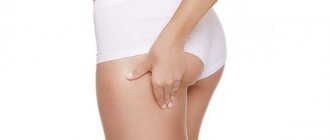Slim hips and buttocks are the dream of many women. For her sake, we are ready to literally move to the gym for permanent residence and courageously switch from one diet to another.
“As my friend, the owner of a classic triangle-type figure, once aptly said: “ears on the hips are like cockroaches, they cannot be removed by anything.”
And I'm ready to agree with her. Triangle, or pear, is the most common type of female figure, when the hips are significantly wider than the bust. The fight against imbalance is complicated by the fact that this distribution of adipose tissue is genetically determined
.
Unfortunately, pears are among those who gain weight easily, and the top-bottom imbalance becomes even more obvious.
You can do massages, body wraps and lose weight until completely transparent. It’s just that you won’t be able to reduce the volume of your hips. The already fragile upper body becomes transparent, but the size of the hips remains the same.”
Anna Smirnova, expert in the field of aesthetic correction of body contours.
Do you want to get slim thighs? In this article, we have collected the most effective tips on how to reduce your hips and buttocks.
They can be used individually, but they will give the greatest effect only in combination.
How to determine whether the pelvis is ready for childbirth?
The main gateway for a baby into this world is the female pelvis. Elastic, mobile and flexible - for all its apparent solidity - it opens to release the child, like a spring flower. This is a beautiful dance that combines body movements, deep breathing, and a single piercing thought: “I am opening up!” In order for childbirth to reveal all the harmony of coordination of movements, breathing and self-absorption, the body must be symmetrical and the pelvis must be mobile.
Posture is one of the most important factors influencing the birth of a baby. The level of standing of the pelvic bones is the position of the pelvic bones in the body relative to each other on the left and right. They can be located symmetrically relative to the body axis or not. If symmetry is broken during childbirth, the forces pushing the baby out are not coordinated, and the child is forced to pass through the twisted birth canal.
The baby is more likely to receive a birth injury, and childbirth is usually more complicated and delayed. Under the influence of many factors (air, water and food pollution, crowded modern city life, lack of mobility), the connective tissue in the body is primarily damaged. The damage manifests itself as connective tissue dysplasia.
If the expectant mother has poor posture or other manifestations of dysplasia, according to the observations of practicing osteopaths, this increases the likelihood of dysplasia in her child. A very common diagnosis now is hip dysplasia. To help yourself and your baby, follow the recommendations of the wellness program, take a protective environmental complex, regularly do gymnastics and walk in the fresh air.
During pregnancy, the pelvis changes. The pelvic joints soften and prepare to expand for the passage of the baby through the birth canal. If the mother had problems with the spine before pregnancy, then it is likely that the position of the pelvic bones will be asymmetrical by the end of pregnancy. Our task is to see these shortcomings and help the body correct them.
Lie on your back on a hard, straight surface. We find the most protruding points of the iliac bones, that is, the most protruding surfaces of the wings of the pelvis. An assistant places one end of a measuring tape on the jugular cavity, the other on the protruding point of the pelvis. We first measure the distance from the jugular cavity to the pelvic bone protruding on the right, then on the left.
The difference in the resulting measurements is calculated. This difference shows us how symmetrical the position of the pelvic bones is relative to each other. Read more about tests for self-assessment of health in the article “Test Yourself.” If the difference does not exceed 0.5 cm, then the pelvis is normal. 1 cm – alarm zone. If there is more than 1 between the obtained measurements.
5cm, then the child may be injured during childbirth. You can try to correct a difference of up to three centimeters by completing the exercises below. After some time, the pelvis will return to its usual incorrect position, and again a difference will appear between the distance from the jugular cavity to the protruding wings of the pelvis on the left and right. But if you do the exercises every day, then by the time you give birth this imbalance will cease to appear at all, and the birth will be easier.
Contraindications and possible harm
The girl’s thigh is located in the hip joint, so if there is pain in the legs or spine, you should consult a therapist before starting classes.
With intense physical exercise, you can have an impact on both problematic parts of the body and the internal systems and organs of the body. In case of failure of any organ, a sharp decline in human health is possible. If contraindications are not followed, no effective exercises will bring the desired result, but rather will worsen the situation.
Intense training is prohibited if one of the following is present:
- pregnancy;
- phlebeurysm;
- high body temperature;
- high blood pressure;
- if a person’s work involves heavy physical activity throughout the working day;
- the presence of problems associated with the genitourinary system;
- oncological diseases;
- in the presence, as well as exacerbation of any form of infectious diseases;
- problems with the gastrointestinal tract;
- problems with the cardiovascular system;
- scoliosis, spondylitis, spondylosis, osteochondrosis, intervertebral hernia, tumors, protrusion of the intervertebral disc and other pathologies of the spine;
- epilepsy.
Working out the leg muscles is prohibited in case of disorders of the joints of the lower extremities and spine.
Such problems include the following diseases:
- arthrosis;
- inflammatory process of the spine;
- excess body weight in the postoperative period;
- injury to the knee or hip joint.
Therefore, before you start working on any set of exercises for the buttocks and thighs, you should consult with your doctor, who will determine whether you can perform physical activity or whether you should give it up for a while.
Despite the fact that nothing previously caused concern, you should be examined by a doctor to identify possible contraindications. This will help you deal with your figure in the future without unnecessary problems, and not with problems that may arise during training.
How to visually enlarge your hips with clothes?
If you are not going to the beach or to the pool, where it will be difficult to disguise your problem hips under a swimsuit, then you can work on your appearance, which will help visually make your figure more proportional.
If we talk about trousers, then tapered and straight options are not for you; the best way out of the situation is tapered trousers, which expand quite well in the right place. Use the upper part of your clothing - it should attract minimal attention to the shoulders and chest, unless you want to gain a significant advantage in the upper zone. Always try to highlight the waistline - with the help of belts, tapered blousons and jackets.
loading…
loading…
In order for your legs to match your beautiful, pumped torso, you need to devote time to them. To build bigger thighs, use a barbell and a high-protein diet.
Exercises with a barbell for the beauty of the hips:
- Coming close to the barbell lying on the floor, squat down and touch it with your knees. With your arms wide apart, grab the bar. Bend at the lower back, spread your shoulder blades and straighten your arms. Moving powerfully, stand on your feet, straightening your body and shrugging your shoulders. The barbell should be lifted close to the body. Having raised the projectile to chest level, squat under it, bringing your elbows forward, place it on your shoulders. Then carefully place the barbell on the floor and repeat the exercise;
- Place the apparatus on the front deltoid muscles and spread your legs wide apart. Tilt your pelvis back a little, bend your knees a little and try to sit down well. It is important to lower the hip joints below the knee joints. Return to the original position and perform the exercise one more time;
- With the barbell on your back and your feet shoulder-width apart, bend your knees. Taking a wide step back, bend both legs and try to keep your weight on your front leg. Returning to the starting position, lunge with your other leg. Repeat the exercise several times for each leg;
- Wrap your hands wide around the bar. With your elbows straight, place the barbell above your head. Squat down. Returning to the starting position, do this exercise several more times;
- Having placed the apparatus on the floor, squat down and touch the bar firmly with your shins. Arch your lower back slightly. Grab the barbell with your hands slightly wider than shoulder-width apart. Push off the floor with your feet and lift the projectile. Aligning it with your knees, straighten your body and stand straight. Holding the barbell, lower yourself to the starting position and repeat;
- Exercises should be done with both heavy and medium weights. The hip muscles are very well pumped with high-intensity short loads. It is recommended to do five repetitions with the maximum weight possible for you.
Anatomy and structure
The girl's thigh is located under an oblique fold of skin, located in the hip joint of the leg and ending approximately 5 cm below the kneecap. The upper part is limited by the gluteal and inguinal ligaments.
Due to its structure, the femoral part of the leg makes it possible to perform movements and is also involved in:
- abduction of the leg in a horizontal plane;
- turning the leg along its axis approximately 180 °;
- squats and lowering the pelvis;
- flexion of the limb.
This area of the body contains large and small blood vessels, as well as nerves. Due to the hip bone, new blood components are formed in the form of leukocytes, platelets and erythrocytes. It has a cylindrical shape with a head at the top. Also located outside is the lesser and greater trochanter, to which the leg muscles are attached. There is an intertrochanteric ridge on the posterior side.
The upper part of the thigh is connected to the pelvis, and the lower part is expanded and forms a pair of processes to which ligaments with muscles are attached.
The general structure and massiveness of the hip bone is explained by the fact that it takes on the main load of supporting the human torso.
The thigh is covered with fascia lata, which is divided into deep and superficial. The first has a loose structure. It is located between the fibers; inside there are nerve endings, blood vessels and lymph nodes. The second consists of a strong and dense structure that envelops the thigh from the outside.
The joint in the pelvis and hip area consists of ligaments. This ensures a stable connection of the hip joint and prevents it from bending during movement or injury.
The hip has a well-developed muscular apparatus that bends around the bone, forming the silhouette of the leg.
The hip senses touch and pain thanks to 3 main nerves:
- The femoral is the largest. It extends from the lumbar region through the entire outer part of the thigh, forming a network of nerve processes that provide sensitivity to the entire thigh.
- Obturator. It originates from the lower back, but is located at the back of the leg.
- Sciatic. It has autonomic, motor and sensory fibers that are located along the entire length of the leg.
Rounding the hips
To round and tighten your hips and become a more attractive woman, you need to systematically perform strength exercises. They need to be performed four times every seven days.
The following exercises will tell you how to make your hips round:
- Standing straight, place your feet shoulder-width apart. Place your arms along your body. Exhaling, shift your whole body onto your right leg and lunge to the side. Place your palms on your right thigh. Inhaling, return to the starting position. Then, as you exhale, lunge to the left. The exercise must be repeated twenty times for each leg;
- Connect your legs and place your palms on your belt. As you exhale, lunge forward with your right leg. Stay in this position for about a minute. Inhaling, return to the starting position. Do the same for the left leg. You need to repeat three more times;
- Place your feet shoulder-width apart, palms back on your hips. As you exhale, squat down, move your tailbone back, and place your hands in front of you. Stay in this position for no more than ten seconds. Your thighs should be parallel to the floor during a squat. Inhaling, take the starting pose. You need to perform fifteen such squats;
- Kneel down and place your palms on the floor under your shoulders. Raise your right leg parallel to the floor. In this case, you need to pull the toe towards you. Stay in this position for sixty seconds. After this, rock up and down for a minute. As you exhale, replace your right leg with your left. And do the exercise one more time in the same way;
- Sit on a covered mat and straighten your legs. Place your hands crosswise on your chest. Step forward with your buttocks at a distance of two meters. Having reached the finish line, use your buttocks to move backwards, backwards, like a caterpillar.
Thanks to such simple daily workouts, you can achieve beautiful rounded shapes in the hips and buttocks in a short time. It is important to perform all exercises smoothly, without sudden movements and systematically.
In addition to a set of exercises, try to take the elevator less, and rather walk up the stairs. This will be a workout for both your legs, hips, butt and spine.
It is important to walk in the fresh air, drink plenty of fluids, and eat foods rich in proteins, fats and carbohydrates. If necessary, after consulting a doctor, you can take a course of vitamins and minerals to strengthen the immune system and maintain muscle mass. By following all the recommendations described above, any woman can make her figure attractive, and her hips and buttocks rounded and expanded.
Week schedule
The girl’s thigh is located in the hip joint, so when developing a training schedule, it is necessary to take into account the fact that it is undesirable to train one zone every day. It is best to alternate between different types of exercises. Since the gluteal and leg muscles are constantly under stress due to the vertical position of the torso, it is recommended to change exercises when the muscles stop responding to them.
Before the main workout, it is necessary to conduct a starting warm-up, which will warm up and activate the muscles, and also increase blood circulation. As a result, it will be easier for the body to cope with stress. As a warm-up, you can rotate your hips, arms and neck, twist your body, jump, and lightly run in place.
It is recommended to take short breaks after each exercise. At the same time, you need to rest once a week.
After completing the main exercises, it is recommended to perform a finishing stretch, based on stretching the muscle groups that were subjected to stress. This is required in order to eliminate pain and also normalize blood flow.
Schedule of the main set of exercises for the week:
| Day of the week | Exercises | Number of approaches | Number of repetitions |
| Monday | Squat | 4 | 10 |
| Lunges | 4 | 10 | |
| Gluteal bridge | 4 | 20 | |
| Tilts | 4 | 10 | |
| Tuesday | Burpee | 4 | depends on possibilities |
| Tilts | 4 | 10 | |
| Wednesday | Tilts | 4 | 10 |
| Swing back on the floor | 4 | 20 | |
| Plie squats | 4 | 10 | |
| Lunges | 4 | 10 | |
| Thursday | Burpee | 4 | if possible |
| Tilts | 4 | 10 | |
| Friday | Bulgarian squat | 4 | 10 |
| Tilts | 4 | 10 | |
| Jump Squats | 4 | 10 | |
| Saturday | Squat | 4 | 10 |
| Lunges | 4 | 10 | |
| Gluteal bridge | 4 | 10 | |
| Tilts | 4 | 10 |
Michaelis rhombus
In order to determine whether the pelvis is mobile and whether its bones are ready to release the baby, we will take a few more measurements on the so-called Michaelis diamond. This is a depression in the sacral region, shaped like a diamond. To find the Michaelis diamond, the assistant places his outstretched palms on the woman's waist, finds the prominent points of the wings of the hips, and places the thumbs together, the fingers joining at the fourth lumbar vertebra.
The top point of the Michaelis diamond we are looking for is one vertebra below. Let's put a dot there with a felt-tip pen (Point A in the picture). On the sides a little lower - in the beach dimples - we'll put two more dots (Points B and D). We place the lowest point of the diamond where the sacrum meets the coccyx (Point C). To understand whether the sacrum “breathes” well, whether it moves as nature intended or whether adjustments will be required, we carry out comparative measurements.
We are interested in how the pelvis will move in different positions. We take the first measurement when the expectant mother is sitting astride a chair, leaning her hands on its back and resting her head on it. We need to find out the length of the vertical line of the Michaelis rhombus. We measure the distance between the two vertical points that we drew (distance from A to C).
After this, mom gets up from the chair. Now, holding onto the chair, she needs to squat down and at the same time take a deep breath. This position opens the pelvis. Once again we measure the same distance from the top point of the diamond to the bottom. If in the “squatting” position the distance between the points is greater than the same distance in the “sitting on a chair” position, then the pelvis is elastic and ready for childbirth.
Young women in good physical shape usually do. Let's measure the second indicator. In the “sitting on a chair” position and in the “deeply crouching” position, we measure the transverse line of the Michaelis rhombus (the distance between points D and B). If the distance increases in the lower position, the pelvis is elastic. Unfortunately, this is now extremely rare.
A little terminology
What a myotonic orgasm is is well known to almost all women, young and old. But the method itself is known, not the name. This is the name of an orgasm that is achieved by squeezing the thighs and buttocks. The intensity and strength can be different: from weak to powerful, rhythmic and constant, in combination with and without pelvic movements. In any case, discharge is achieved without additional stimulation of the genitals. Although in some cases a woman can use various devices. But they serve more as amplifiers of the effect than as direct “suppliers” of satisfaction.
Why is the pelvis inelastic?
What are the reasons for this abnormal pelvic position? Modern research suggests that the main factor in the improper development of the pelvis is a sedentary lifestyle during school years. Having good physical fitness turns out to be insufficient. The very position of “sitting at a desk” for many hours is harmful. After all, instead of various movements and physical activity during the years of the most intensive formation of the skeletal system, expectant mothers sit motionless every day during their lessons.
That is why in the experimental groups of kindergartens working under the program “Towards a Healthy Family through Kindergarten”, instead of chairs at each desk there is a fitball corresponding to the child’s height. A child sitting at the table not on a chair, but on a fitball, provides constant micromovements to the pelvis. It is simply impossible to sit calmly and motionlessly on a fitball for a long time.
When to expect the effect
Hips will be beautiful if you exercise regularly and eat right. The positive effect of exercise can be obtained both after 14 days and after several months. Everything will depend on the purpose of the training.
If you only need to develop strength, the result will be noticeable after 2 weeks, since the body adapts to the load very quickly. Muscle gain will appear after 90 days, but only if you constantly train and eat right.
For many girls, the hips are considered a problem area, since there may be fat deposits that manifest themselves in the form of cellulite. Due to a sedentary lifestyle, muscles become weakened. To get into shape and lose excess body weight, you need to exercise regularly. Moreover, training can be carried out not only in the gym, but also at home. The effect will be the same if you do everything correctly and give 100%.
Exercises to soften the pelvic joints
During pregnancy, the pelvis easily changes its position. To help yourself, you should regularly perform three simple exercises. These exercises increase the distance between the horizontal points of the Michaelis diamond (beach dimples) when squatting compared to standing. The pelvis will become more elastic, the ligaments will be more flexible, and now the body is ready for childbirth.
Penguin step
We put our feet in the first choreographic position, that is, heels together, toes apart. Squeezing our buttocks, we step forward with a penguin gait, our stomach moves from side to side, we take steps in the same position in which we placed our legs at the beginning. We walk like this every day for 3 minutes.
Deep squat
We squat, holding hands with a partner. In a squat, we strive to pull the tailbone under ourselves without pushing the lower part back. It is advisable to sit down in such a way that, slightly leaning away from your partner, you enter into balance with him, in which you both will hold each other, leaning your shoulders back. The knees practically do not extend beyond the line of the feet.
Do not lift your heels off the floor. This exercise is included in the “Osteopathic gymnastics for pregnant women” complex. We do it every day in the morning. You can sit down without a partner. For example, grabbing the headboard or door frame. A chair will not work here as it will not support your weight. But in general, it is advisable to be in this position – crouching deeply, with your knees wide apart – as often as possible.
For example, watching a movie or talking on the phone. Knees placed wide apart is such an unusual leg position for a European woman, but nevertheless, it is the most useful for future childbirth. (Birth position No. 8) In Asian cultures - not yet so far removed from naturalness - a squatting position with knees wide apart is common. And wide, long skirts help women maintain decorum.
Stretch "Mountain"
You can open the joints through exercises that move the pelvic bones apart. As a result, a fairly wide interarticular space is formed, where synovial fluid begins to be intensively produced. It nourishes the cartilage layer and smoothes out friction in the joint capsule.
The process of opening the joint itself is traumatic. Therefore, it is necessary to follow several rules in its implementation:
- Before performing the exercise, carefully study each step. The instructions always provide detailed information about unexpected nuances that at first glance seem unimportant for a particular exercise.
- Perform all actions gradually and slowly. This is the most important principle that will help you move forward without discomfort in your body. Rapid stretching inhibits the tissues ability to adapt naturally.
- Stop if you feel significant pain. This indicates disturbances in blood circulation.
Make pelvic opening exercises regular and systematic. At least 2-4 workouts should be done every week.
The most effective exercises for stretching the joints of the pelvic area are presented in yoga.
This exercise is especially effective for increasing the elasticity of the pelvis and working out the ligaments involved in childbirth. To perform it, we will take the starting position on all fours - it is similar to birth position number 4 from the “Osteopathic gymnastic complex for pregnant women.” We lower ourselves to the floor with our legs tucked under us. We bring the big toes together, sitting between the heels.
We spread our knees to the sides. We take a breath, raise our hands up, and look at them. This is "mountain". Then we lower our hands down in front of us and lean properly on our wrists - we take root. This is a "hill". We move forward with our wrists pressed to the floor. At the same time, do not separate the heels from the buttocks. Having lowered ourselves to the very end, when our forehead barely touches the floor, we sway a little, springing in the shoulder joint.
Then we crawl gradually back, still stepping with our wrists. We take a breath, raise our hands up again - “mountain”. You need to make several such transitions from the “hill” to the mountain. Experts even recommend sleeping a little in the “mound” position. At the same time, if your legs become numb, there is no need to worry. After a week of such exercises, the vessels will get used to this load, reorganize themselves, and the legs will stop numbing.
Why are they needed?
A girl's figure, located in the hips and buttocks area, may have various types of deviations from the norm.
The most common problems are described in the following list:
- a large amount of deposits in the thigh area;
- sagging and flabbiness in the gluteal region and hips;
- very thin thighs;
- thin and weakened gluteal muscles.
With regular fitness classes and careful training of the thigh muscles, the processes listed in the following points are triggered:
- fatty tissue on the thighs decreases in volume;
- lymph flow and blood circulation are normalized, which has a beneficial effect on the reduction of cellulite;
- physical indicators of leg muscle strength increase;
- the silhouette of the figure becomes more attractive;
- the articular-ligamentous apparatus increases its functionality;
- The core and muscle tissue of the lower extremities are strengthened and acquired relief.
How the pelvis “breathes”
The movement of the pelvis during inhalation and exhalation with elastic ligaments should be noticeable. If, when inhaling, you try to draw in air, expanding your stomach, lowering the diaphragm down, then the pelvic bones will move. This type of breathing is called diaphragmatic breathing, it is natural for a healthy body, and only stress and poor lifestyle make us breathe shallowly.
In order for the baby to pass properly through the birth canal, as well as to relieve pain from contractions, during childbirth you need to breathe so that the pelvis expands. To check how correctly you are breathing, you need an assistant who will observe the movements of the pelvis during breathing. It is more convenient for an assistant to observe the pelvis when the expectant mother sits “astride” on a chair, leaning on the back of the chair.
She puts her head in her hands and rounds her back. Her tailbone is not touching the chair. An assistant observes the movement of the pelvis from the back. Observe your breathing by placing your palms on your shoulder blades. To see how the pelvis “breathes,” the assistant first tries to follow the desired movement under his palms at the level of the shoulder blades. The assistant places his palms on the mother's shoulder blades, the thumbs are joined together in the middle of the back, the remaining fingers are spread apart.
Mom takes a breath - and the assistant watches how his thumbs move apart. Exhale - fingers connect. Observe your breathing by placing your palms on the diaphragm. Let's watch a little lower how the pregnant woman's breathing spreads the assistant's hands. He now places his palms at the level of the diaphragm. And he also watches how his thumbs move apart as his mother inhales.
2.Drink plenty of water
It seems what water has to do with it and how it affects calorie burning. The body, deprived of a sufficient amount of water, on the contrary, retains water, which can cause swelling and make the figure fuller. With a low concentration of water in the body, metabolism decreases, the skin becomes less elastic and wrinkled.
What to do?
Drink at least 34 mg of water daily. for 1 kg. weight, for example a girl weighing 55 kg. I should drink 34 mg per day. x 55 = 1.87 l. water. Please note that the water must be clean without gas and under no circumstances replace it with sweet drinks, they contain sugar, which can cause carbohydrate addiction and burn excess calories in the body. Find out more about the benefits of water for the body here.
Osteopathic breathing enhancement
Helpers can enhance the effect of pain relief, improve the baby's oxygen supply, and also give the mother the opportunity to feel help and attunement by placing their hand on the sacrum and trying to breathe with the expectant mother in her rhythm. In the mother's sitting position. Mom sits upright on a chair, putting her hands on its back, leaning on them.
The assistant sits on the floor on the side of the mother's sacrum. He covers the sacrum completely with his palm, resting his elbow on his knee so that he can press on the mother’s sacrum, strengthening the emphasis with his knee. Presses tightly and smoothly on the sacrum with the whole palm, merging with it. As you inhale, imagine how the sacrum expands and moves upward, towards the palm of the assistant.
As you exhale, imagine how it hides inside. The elastic pelvis can be felt if all the described movements are well felt under the palm of the assistant. An inelastic pelvis needs such support even more so that after a few days of exercise it becomes more mobile and pliable. In the mother's position lying on her side. Mom lies on her side, trying not to arch her back.
You can round it by pulling your knees closer to your stomach. The assistant places his palm on the sacrum and focuses on its movements. He synchronizes his breathing with his mother's. This support increases the flow of oxygen to the baby and relieves pain during labor. Future parents can practice this attunement in breathing every time they go to bed. Mom lies on her side, and dad puts his hand on the sacrum, breathing synchronously.


